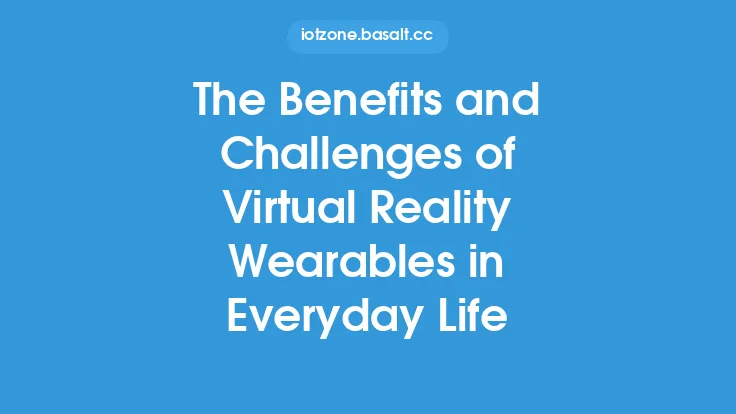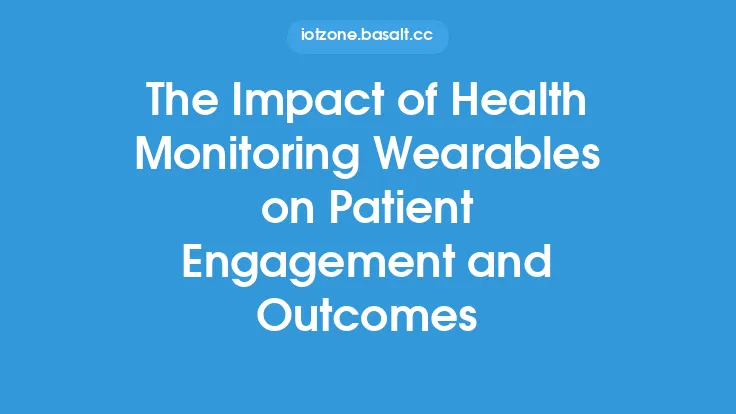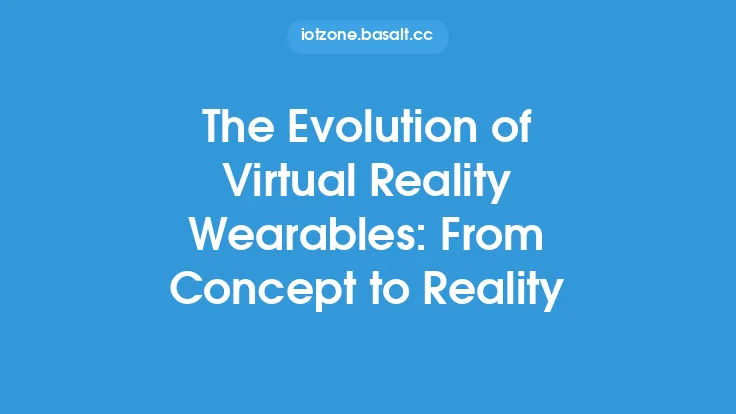The concept of virtual reality (VR) wearables has been gaining significant attention in recent years, particularly in the context of mental health and wellness. As technology continues to advance, VR wearables have become increasingly sophisticated, offering a wide range of applications and benefits for individuals seeking to improve their mental wellbeing. In this article, we will delve into the impact of VR wearables on mental health and wellness, exploring the various ways in which they can be used to support and enhance mental health outcomes.
Introduction to Virtual Reality Wearables and Mental Health
Virtual reality wearables are devices that use a combination of hardware and software to create immersive, interactive environments that simulate real-world experiences. These devices can be used to transport individuals to new and unfamiliar environments, providing a unique opportunity for exposure therapy, relaxation, and stress reduction. In the context of mental health, VR wearables have been shown to be effective in reducing symptoms of anxiety and depression, improving mood, and enhancing overall wellbeing. By providing a safe and controlled environment, VR wearables can help individuals confront and overcome their fears, anxieties, and phobias, leading to improved mental health outcomes.
The Science Behind Virtual Reality Wearables and Mental Health
The science behind VR wearables and mental health is rooted in the concept of neuroplasticity, which refers to the brain's ability to reorganize and adapt in response to new experiences and environments. When individuals use VR wearables, their brains are able to rewire and reorganize, leading to changes in thought patterns, behaviors, and emotional responses. This can be particularly beneficial for individuals with mental health conditions such as post-traumatic stress disorder (PTSD), where the brain's ability to process and respond to traumatic events can be impaired. By using VR wearables, individuals can relearn and reprocess traumatic experiences, leading to improved mental health outcomes and reduced symptoms of PTSD.
Applications of Virtual Reality Wearables in Mental Health
There are a wide range of applications for VR wearables in mental health, including exposure therapy, cognitive behavioral therapy (CBT), and mindfulness-based stress reduction (MBSR). Exposure therapy, for example, involves gradually exposing individuals to simulated environments that trigger anxiety or fear responses, allowing them to become desensitized and build confidence. CBT, on the other hand, involves using VR wearables to identify and challenge negative thought patterns and behaviors, leading to improved mental health outcomes. MBSR, which involves using VR wearables to practice mindfulness and meditation, has been shown to reduce symptoms of anxiety and depression, improve mood, and enhance overall wellbeing.
Technical Requirements for Virtual Reality Wearables in Mental Health
In order to be effective in mental health applications, VR wearables must meet certain technical requirements. These include high-resolution displays, advanced tracking systems, and sophisticated software that can simulate realistic environments and interactions. Additionally, VR wearables must be designed with comfort and usability in mind, allowing individuals to wear them for extended periods of time without experiencing discomfort or fatigue. Some of the key technical specifications for VR wearables in mental health include:
- High-resolution displays with a minimum resolution of 1080p
- Advanced tracking systems that can track head and body movements
- Sophisticated software that can simulate realistic environments and interactions
- Comfortable and adjustable headsets that can be worn for extended periods of time
- Advanced audio systems that can provide immersive and realistic sound
Benefits and Limitations of Virtual Reality Wearables in Mental Health
The benefits of VR wearables in mental health are numerous, including improved mental health outcomes, reduced symptoms of anxiety and depression, and enhanced overall wellbeing. Additionally, VR wearables can provide a safe and controlled environment for individuals to confront and overcome their fears, anxieties, and phobias. However, there are also limitations to the use of VR wearables in mental health, including the potential for addiction, social isolation, and decreased physical activity. Furthermore, VR wearables can be expensive and may not be accessible to all individuals, particularly those in low-income or rural areas.
Future Directions for Virtual Reality Wearables in Mental Health
As technology continues to advance, we can expect to see significant improvements in the design and functionality of VR wearables for mental health applications. Some potential future directions include the development of more advanced tracking systems, improved software that can simulate realistic environments and interactions, and increased accessibility and affordability. Additionally, there is a need for further research on the effectiveness of VR wearables in mental health, including large-scale clinical trials and studies that can provide more definitive evidence of their benefits and limitations.
Conclusion
In conclusion, VR wearables have the potential to revolutionize the field of mental health, providing a safe and controlled environment for individuals to confront and overcome their fears, anxieties, and phobias. With their ability to simulate realistic environments and interactions, VR wearables can be used to support and enhance mental health outcomes, reducing symptoms of anxiety and depression, and improving overall wellbeing. As technology continues to advance, we can expect to see significant improvements in the design and functionality of VR wearables for mental health applications, leading to increased accessibility and affordability for individuals around the world.





